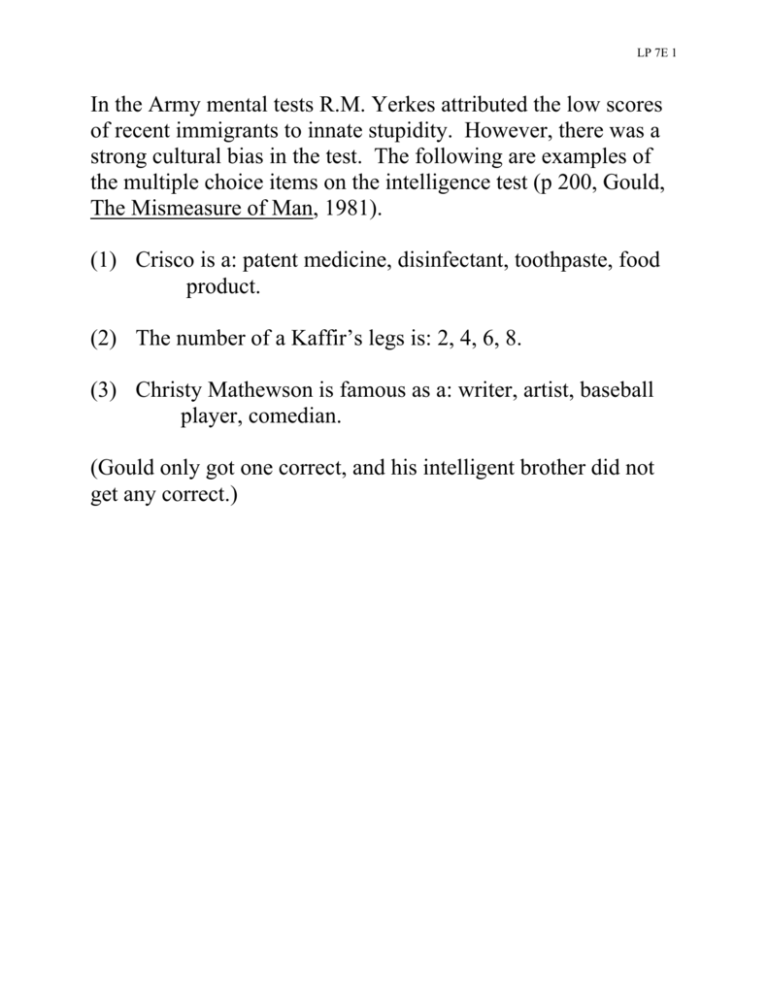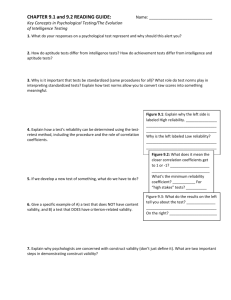
LP 7E 1
In the Army mental tests R.M. Yerkes attributed the low scores
of recent immigrants to innate stupidity. However, there was a
strong cultural bias in the test. The following are examples of
the multiple choice items on the intelligence test (p 200, Gould,
The Mismeasure of Man, 1981).
(1) Crisco is a: patent medicine, disinfectant, toothpaste, food
product.
(2) The number of a Kaffir’s legs is: 2, 4, 6, 8.
(3) Christy Mathewson is famous as a: writer, artist, baseball
player, comedian.
(Gould only got one correct, and his intelligent brother did not
get any correct.)
LP 7E 2
The following is one of Terman's original questions (Gould, The
Mismeasure of Man, 1981, page 176):
An Indian who had come to town for the first time in his life
saw a white man riding along the street. As the white man
rode by, the Indian said-- "The white man is lazy; he walks
sitting down."
What was the white man riding on that caused the Indian to say,
"He walks sitting down."?
Write your answer down on the margin of a piece of paper. DO
NOT share your answer until everyone has an answer.
(Gould, The Mismeasure of Man, 1981, page 176):
LP 7E 3
Items No Longer Included in Intelligence Tests
Runner : Marathon
(a) envoy : embassy
(b) martyr : massacre
(c) oarsman : regatta
(d) referee : tournament
(e) horse : stable
What is the bias in this question?
Some typical IQ items are based on knowledge of upper middleclass culture.
If standardized tests reflect white, middle-class cultural
knowledge and values, minority-group members might do
poorly on the tests not because of lower intelligence, but
because of unfamiliarity with the white middle-class culture.
LP 7E 4
Is there a cultural bias in I.Q. test?
Do I.Q. tests favor one culture over the other?
ß What have we looked at that might suggest that intelligence is
affected by your culture?
ß How do expectations affect performance on I.Q. tests.
ß What are the consequences?
Take the Dove counterbalance tests.
Why didn’t any criticisms of the valid arguments for the cultural
bias in IQ tests affect its use?
People do not take into situational factors that occurred in the
United States at that time (the fundamental attributional error).
There were strong anti-immigrant sentiments and thus the IQ
tests reflected current belief in “the public mind”. Evidence
supporting the belief that IQ tests were culturally fair was given
light scrutiny and evidence counter to this position was harshly
criticized (____-___)
LP 7E 5
Principles of test construction
Standardization:
Reliability:
Validity:
The administration of a test to a large,
representative sample of people under
uniform conditions for the purposes of
establishing performance norms. For the
first part of standardization, when tests are
done for children’s medicines, it should be
done on children, not adults. Likewise,
tests for the general population should
tested with the general population, and not
a subgroup. The test sample should
represent the population.
The ability of a test to produce consistent
results when administered on repeated
occasions under similar conditions. If you
are given an I.Q. test, then you should get a
similar score if you take it 3 months from
now, or even 1 year from now.
The ability of a test to measure what it is
intended to measure. If it is designed to
measure intelligence, it measures
intelligence and not cultural knowledge,
problem solving, basic knowledge, logic,
etc. If a test is designed to measure
honesty, it should measure honesty, and not
social desirability. Horoscopes should
describe your personality, not anyone elses.
These principles applies to tests of intelligence, SAT’s,
personality tests, honesty test, multimeters, speedometers, etc.
LP 7E 6
Low reliability
High reliability
Low
validity
High
validity
Based on the definitions of reliability and validity, what should a
pattern of “hits” look like on each target for the combination of
validity and reliability?
Reliability:
Validity:
The ability of a test to produce consistent results when
administered on repeated occasions under similar
conditions.
The ability of a test to measure what it is intended to
measure. Think of this as precision.
LP 7E 7
Standardization:
Reliability:
Validity:
The administration of a test to a large,
representative sample of people under
uniform conditions for the purposes of
establishing performance norms.
The ability of a test to produce consistent
results when administered on repeated
occasions under similar conditions.
The ability of a test to measure what it is
intended to measure
Why is it important to understand these principles of test
construction?
Have you ever had to take a variety of tests to measure honesty
or hostility to get a job?
LP 7E 8
Critical Thinking: Symptoms of Repressed Memories
A number of books have popularized the notion that repressed memories
of childhood abuse are actually very common. One feature that many of
these books have in common is a checklist of symptoms to help you
determine whether you are a repressed memo victim. Psychologist
Elizabeth Loftus (1994) has collected a number of “symptoms” from
checklists in these books. What do you think about the following items?
• Do you have trouble knowing what you want?
• Do you follow other people’s suggestions as if they were orders to
be observed?
• Do you wear a lot of clothing, even in summer? Do you favor
baggy clothing?
• Have you ever had a period of sexual promiscuity in your life?
• Do you often have nightmares?
• Do you have difficulty falling or staying asleep?
• Do you “space out” or daydream?
• Do you feel different from other people?
• Do you have trouble feeling motivated?
• Do you use work or achievements to compensate for inadequate
feelings in other parts of your life?
Questions to ask yourself:
• Do you believe that a person who answers “yes” to most of these
questions is likely to be suffering from repressed memories?
• Suppose that someone tells you that 75% of incest survivors
exhibit these symptoms. Would this convince you? Why or why
not?
• Imagine that a friend has one of these books, and is now worried
that she might have forgotten acts of abuse in her past. How would
you counsel her?
Loftus, B., & Ketcham, K. (1994). The myth of repressed memory: False
memories and allegations of sexual abuse. New York: St. Martin’s Press.
LP 7E 9
Alien Abductions
Personal accounts of alien abductions have increased since the
publication of Bud Hopkin’s books Missing Time (1981) and Intruders
(1987) and Whitley Strieber’s Communion (1987).
The claim that 3.7 million Americans have been abducted was based on
a Roper Poll conducted between July and September 1991 and published
in 1992. The authors were Bud Hopkins, a painter and sculptor; David
Jacobs, a historian; and Ron Westrum, a sociologist.
In this case, a representative sample of 5,947 adults were given a card
listing eleven experiences and were asked to say whether each had
happened to them more than twice, once, or twice, or never. Of these
eleven were five “indicator experiences”.
1. Waking up paralyzed with a sense of a stranger person or presence
or something else in the room (18%).
2. Feeling that you were actually flying through the air although you
didn’t know where or how (10%).
3. Experiencing a period of time of an hour or more, in which you
were apparently lost, but you could not remember why, or where
you had been (13%).
4. Seeing unusual lights or balls of light in a room without knowing
what was causing them, or where they came from (8%), and
5. Finding puzzling scars on your body and neither you nor anyone
else remember how you received them or where you got them
(8%).
The authors decided that when a respondent answered yes to at least four
of these five indicator questions, there is a strong possibility that
individual is a UFO abductee. The only justification given is that
Hopkins and Jacobs worked nearly 500 abductees over a period of 17
years. 119 of the 5,947 people (2%) had four of the five indicators.
Extrapolating to the population of 185 million, that total number in
America abducted by aliens is about 3.7 million people.






